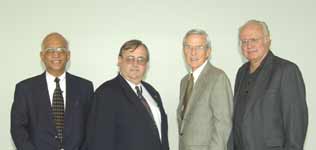|
Text of ISA TODAY news coverage
|
|
“The reason jobs are going down [in number] is because jobs are going down everywhere,” said Morley, speaking at a Pinto-led panel Wednesday titled “Debunking the Myths: The Good, the Bad and the Future of Outsourcing.”
“Jobs are going down the silicon hole, not the outsourcing hole,” said the colorful Morley. Best known as the inventor of the programmable logic controller (PLC), Morley is a futurist and venture capitalist who has helped start more than 100 companies in the New Hampshire area, his home base.
Responding to a question from Ken Ball, one of several hundred show goers attending the forum, Pinto and Morley produced figures to support their contention that productivity resulting from automation—not outsourcing—was the biggest culprit behind most U.S. manufacturing job losses.
Only 300,000 U.S. job losses—about 15%—resulted from offshore outsourcing, Pinto said.
Morley said he was at a meeting on outsourcing at the Massachusetts Institute of Technology (MIT) also attended by representatives of industry giants GE and IBM, among others. While there, figures were produced showing all industrialized countries are losing manufacturing jobs—including China.
According to the MIT study, about 11% of China’s manufacturing jobs have disappeared, he said.
Walt Boyes, the outspoken editor of CONTROL magazine told the large audience bluntly, "Outsourcing is here to stay. Get used to it!"
Another panelist, Jim Teegarden, a longtime senior manager at Fisher Controls who co-founded intervention management consulting firm Valpers Performance Partners, Inc., approached outsourcing from what he acknowledged was a “pragmatic” viewpoint.
Teegarden underscored that global sourcing should be “a strategic decision, not a short-term cost saving.” Senior management needs to be very involved because of potential risks and pitfalls, he said.
Without naming the specific clients, Teegarden gave three examples where he had been called in after outsourcing-related problems developed.
In one instance, the parent company forced one of its subsidiaries to go offshore for component parts, expecting cost savings. However, the components built offshore did not meet specifications. Management decided to try and use the faulty components anyway, which ultimately resulted in customers losing faith and a big drop in employee morale.
Citing another example, Teegarden said a U.S. manufacturer’s joint venture company overseas built a valve exactly like a product made by the U.S. firm, and their intellectual property and product expertise was lost.
Issues around losing intellectual property “are going to get a lot worse” in the future, Teegarden warned.
“Don’t ever outsource the crown jewels,” Morley agreed.
In a third instance, serious communications problems arose because of differences in languages.
“Employee morale is a key issue,” Teegarden underscored. “Global sourcing is not easy. It requires involvement, support, and commitment of senior management.”
Pinto, founder and former chief executive officer of Action Instru-ments who now is an author and technology futurist, disclosed he talked to CEOs at Honeywell, GE, and Rockwell, hoping they would agree to allow someone from their firms to participate in the Wednesday panel.
All three do significant manufacturing and/or assembly overseas, he said. However, all three turned Pinto down, saying, in one way or another, outsourcing was “an unpopular subject” that they did not want to discuss publicly.
Underscoring how extensive outsourcing has become, Pinto said giant retailer Wal-Mart buys $12 billion worth of goods overseas each year and, in effect, “is a direct outlet for Chinese goods.”
Looking at potential future ramifications, Pinto said China could put a satellite into orbit at a fraction of what NASA would charge. If NASA provided rocket and launch services, the cost would be at least $1 million to $2 million, according to estimates. Pinto said China could do it for perhaps as low as $20,000.

|
 Return to ISA EXPO 2004 Pinto Keynote
Return to ISA EXPO 2004 Pinto Keynote
If you have ideas or suggestions to improve this site, contact: webmaster@jimpinto.com
Copyright 2003 : Jim Pinto, San Diego, CA, USA
 Delivering a wake-up call to some in the audience who seemed convinced cheap labor overseas was the reason behind U.S. manufacturing job losses, outspoken ISA EXPO 2004 panelists Dick Morley and Jim Pinto were quick to rebut that “myth.”
Delivering a wake-up call to some in the audience who seemed convinced cheap labor overseas was the reason behind U.S. manufacturing job losses, outspoken ISA EXPO 2004 panelists Dick Morley and Jim Pinto were quick to rebut that “myth.”